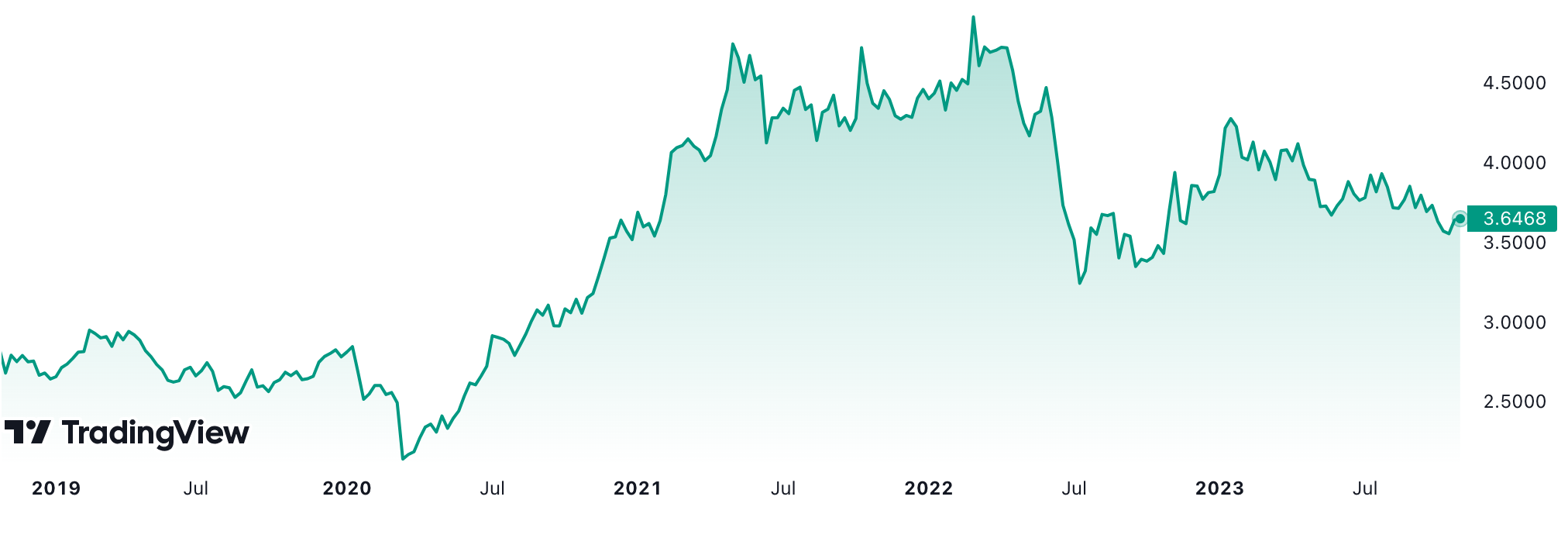A beginner’s guide to battery metals (and 14 ways to invest)
As far as investing megatrends go, the global energy transition is one of the biggest, requiring some US$194 trillion of investment by 2050, according to Bloomberg New Energy Finance.
The energy transition is periodically bumped off the financial headlines by a range of things. These include the surge of AI and the “magnificent 7” technology names and, sadly, the outbreak of war in the Middle East alongside the continuing Russia-Ukraine conflict.
The last two of these highlight the global importance of diversifying global energy sources and supply chains. On the supply side, Russia’s invasion of Ukraine heightened the geopolitical risk associated with one of the world’s top oil suppliers, at a time when overall investment is flagging due to market-based and political factors. Such concerns are further heightened by renewed hostilities in the Middle East, one of the world’s key energy-producing regions.
These crises further emphasise the importance of the energy transition investment theme. But how can individual investors put their money to work within this global phenomenon?
Following on from the first wire in this two-part series, which looked at “traditional” commodities, the following considers those deemed critical to the energy transition.
Often known as “battery metals” or “green metals,” the demand for the following materials has surged within the last decade:
- lithium
- graphite
- nickel
- rare earths, and
- copper.
Much of the demand is driven by the manufacturers of batteries, the primary power source for electric vehicles. The demand for lithium-ion batteries rose 65% last year, according to IEA research. Huge demand is also driven by the energy storage market, including the likes of the Tesla Powerwall, LG Home Battery, and many others.
Across the first three on the above list, about 60% of lithium, 30% of cobalt and 10% of nickel demand was for EV batteries. These figures were just 15%, 10% and 2% only five years earlier.
Nickel’s demand is the most concentrated, driven by a combination of stainless steel and batteries, and with fewer supply constraints. My colleague at Market Index, Kerry Sun, recently wrote about an impending “tsunami of supply” from Indonesia that underpins a view that nickel doesn’t have much leverage, in the short-term at least.
Graphite also faces price pressures for a few main reasons, partly because of the offsetting influence of synthetic graphite. More pure than natural graphite, this material is ideal for low-tolerance applications such as semiconductors and batteries. But it’s also energy-intensive to produce, meaning its highly leveraged to oil prices – that’s why the prices of graphite anodes spiked after Russia’s invasion of Ukraine sent WTI crude to US$130 a barrel. The oil price has since pulled back, despite rising in recent weeks on the back of the Israel-Palestine conflict, trading at around US$85 currently.
China controls 78% of global natural graphite, 58% of synthetic graphite production, 99% of refined production and 93% of the anodes used in EVs are produced in China too, according to Benchmark Minerals Intelligence.
“Unless we see a headline along the lines of ‘China clamps down on synthetic graphite production’, this could be placing downward pressure on graphite prices,” wrote Kerry Sun in June.
Rare earths, specifically the elements neodymium, praseodymium, terbium, dysprosium, and boron – are also critical to the manufacture of EV motors. Some estimates suggest the demand for rare earth oxides could increase from 171,300 metric tons in 2022 to 238,700 metric tons by 2030, the Wall Street Journal reported in April.
But as with other parts of the EV supply chain, including the production of the materials mentioned above, China also dominates the refining of rare earths, controlling as much as 85% of global processing. That’s why the likes of Tesla have been seeking alternatives for its EV batteries. It’s also why moves by companies such as Lynas Rare Earths (ASX: LYC) attract so much attention.
Just this week, the Malaysian Government overturned a restriction on Lynas’ importing and processing of key elements used in the production of wind turbines and electronics, as reported in the Australian Financial Review. Lynas is the biggest supplier of rare earths outside of China.
Copper is, of course, crucial in the manufacture of EVs, wind turbines and most other applications in the broader electrification theme. But unlike the others in the list, it is priced like an industrial metal.
“Copper has a wall of worries to climb before it can reach a promised land where the market is in a clear-cut deficit, the commodity is priced like a battery metal and miners return to profitability,” Kerry Sun wrote in June.
“The copper we know right now is not exactly the one investors typically associate with monstrous demand from megatrends like decarbonisation and EVs. If it was, prices wouldn’t be unchanged in the past two years and down 15.9% in the past twelve months.”
And the copper price has fallen further since then, to $3.66 from $3.77 on 5 June.
Copper prices over five years

“At the moment we are concerned about the global growth environment and recessionary fears and that’s a negative, in the short term, for commodities like copper,” Shaw & Partners’ Andrew Hines said in June.
“But that’s a small intra-cycle within a bigger picture and it’s the reason why I say now is the time to get yourself set for those bigger picture thematics.”
how to invest
Buying shares in companies that produce or refine “green metals” is an obvious way to invest in the electrification theme. Alongside Lynas, as mentioned above, the following are some of those discussed by Livewire contributors recently.
Copper stocks
Among large-cap ASX companies, Shaw & Partners’ Hines noted the difficulty of finding pure-play exposures but pointed to BHP Group (ASX: BHP) “as a good proxy for the broader sector.”
He also referred to the Gold producers as a source of copper exposure, given the two metals are often produced together, citing Evolution Mining (ASX: EVN) as an example.
Among smaller companies, Hines named $138 million market-cap explorer Aic Mines (ASX: A1M) as a stock on his radar.
Lithium stocks
Acorn Capital’s Rick Squire, speaking with my colleague Ally Selby this week, named Liontown (ASX: LTR), Azure Minerals (ASX: AZS) and Patriot Battery Metals (ASX: PMT) among his preferred ASX lithium plays.
Both Liontown and Azure have made headlines recently following approaches by global lithium juggernauts Albemarle and SQM, respectively – deals that have so far been unsuccessful after blocking manoeuvres from major shareholder Gina Rinehart.
Noting the performance of the three companies versus others in the space, Acorn Capital's Squire believes this reflects the quality of the projects operated by Liontown, Patriot and Azure. “They're large deposits and they're very mineable. They've got the right metals and they're in quite reasonable locations,” Squire said.
Graphite stocks
Syrah Resources (ASX: SYR) is the ASX’s largest producer of graphite, a company Morgan Stanley analysts recently named in a report on China’s plans to expand export controls.
As Kerry Sun wrote, the analysts noted the limited impact on current Chinese graphite prices but also the recent surge in graphite companies like Syrah and Talga Group (ASX: TLG).
Another way to invest in “green metals”
For investors seeking broader, simpler exposure to the energy transition, including companies listed in foreign markets, there are several locally-listed exchange-traded funds to consider.
Some of the drawbacks of buying companies directly are highlighted by the activity mentioned earlier surrounding Liontown and Azure Minerals. This gives rise to further regulatory risks mining company shareholders need to consider, as explained in a strongly worded article from Livewire contributor Kingsley Jones this week.
Other arguments against direct investment in battery metal miners include the opacity of pricing for the likes of lithium and rare earths. With only a small number of lithium-producing nations in Australia, Chile and China, the demand base is smaller still, with China producing almost 80% of all lithium-ion batteries. This leaves prices exposed to geopolitical factors, including trade disputes, export restrictions, and political instability.
The following list was compiled using a combination of the Livewire Markets fund database, which you can access here, and information from individual websites.
Note: This is not financial advice. Please consult a financial planner and consider your individual circumstances before making any investment decision.
Assets under management and fee information is current as of 30 October 2023, unless stated otherwise.
Global X Battery Tech & Lithium ETF (ASX: ACDC)
Performance: 13.56% since inception.
Total assets: $527.24 million.
Launch date: 30 August 2018.
What it costs: 0.69%
Summary: One of the oldest Australian ETFs in the space, ACDC is also a top-five performer in the 12 months to the end of June 2023, as tracked by the ASX. Tracking the Solactive Battery Value-Chain Index, ACDC provides exposure across the supply chain, including mining, refinement, and battery production across multiple markets.

Global X Copper Miners ETF (ASX: WIRE)
Performance: -14.73% (3 months)
Total assets: $121.03 million.
Launch date: 21 November 2022.
What it costs: 0.65%
Summary: Tracking the Solactive Global Copper Miners Total Return Index, WIRE provides access to a global basket of copper miners that may benefit from structural tailwinds across the clean energy value chain.

Global X Green Metal Miners ETF (ASX: GMTL)
Performance: -22.33% since inception
Total assets: $1.88 million.
Launch date: 24 October 2022.
What it costs: 0.69%
Summary: GMTL provides exposure to global companies that produce critical metals for clean energy infrastructure and technologies, including lithium, copper, nickel, and cobalt. Its top three country weightings are China (33%), US (17% ) and Canada (9.6%) as of 30 October 2023.

Betashares Energy Transition Metals (ASX: XMET)
Performance: -5.42% since inception.
Total assets: $20.35 million.
Launch date: 26 October 2022.
What it costs: 0.69%
Summary: Tracking the Nasdaq Sprott Energy Transition Materials Select Index, XMET provides exposure to global producers of copper, lithium, nickel, cobalt, graphite, manganese, silver, and rare earth elements. Top three country weightings are Australia (17.5%), US (16.1%) and Chile (15.1%).

VanEck Global Clean Energy ETF (ASX: CLNE)
Performance: -10.27% since inception.
Total assets: $87.59 million.
Launch date: 8 March 2021.
What it costs: 0.65%
Summary: CLNE tracks the S&P Global Clean Energy Select Index, which measures the performance of 30 of the largest and most liquid companies with businesses related to clean energy production and associated technology and equipment globally, from both developed and emerging markets. These include companies involved in biofuel, biomass and geothermal energy production, hydroelectricity along with solar and wind energy production.

What's your battery metals play?
Please let us know in the comments below how you've bought into the electrification theme – whether an ETF, managed fund or stock and give us your investment thesis.
5 topics
14 stocks mentioned
5 funds mentioned
2 contributors mentioned

